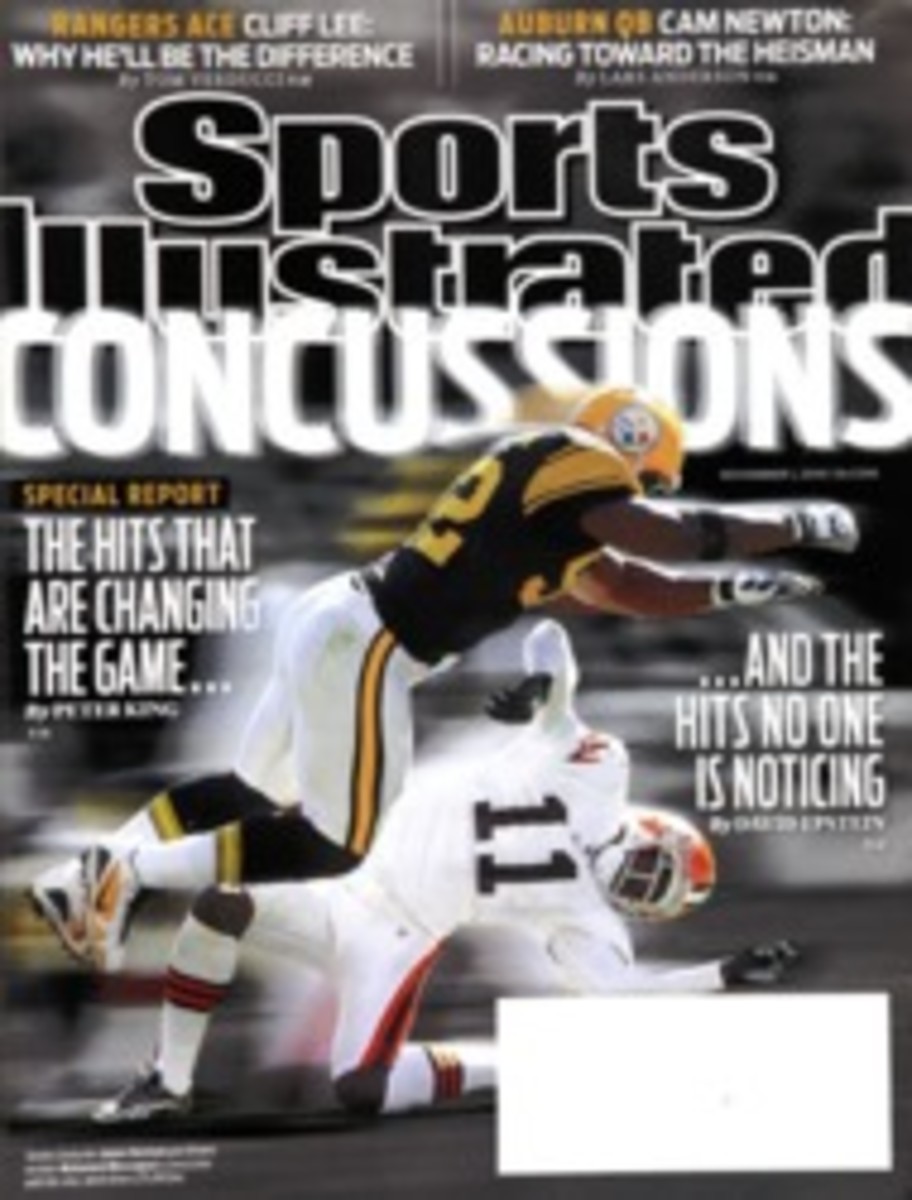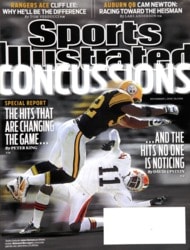
Staggered by The Impact
On the wall outside my office at SI is a photograph from 1960 of Philadelphia Eagles middle linebacker Chuck Bednarik pumping his fist triumphantly over Frank Gifford, who lies limp on the chewed and broken turf of Yankee Stadium. The versatile Giants halfback had taken a pass over the middle, where the relentless Bednarik had blindsided him at full speed, straightening him up and back with a shoulder and forearm under the chin. It was a devastating hit; it was also rule-book fair. Gifford was hospitalized with a concussion and did not play football again until 1962.
The black-and-white image is nine feet long and four feet high and covers the wall like a mural. I put it there to remind all of us at SI that we are in a very competitive business and to signal to anyone coming to my office that I had played football and respected the game's toughness and its values. From now on it will also remind me that in sports, as in life, sometimes the rules need to change.
If you have ever had a concussion or just been hit hard in the head, you know that it is not the pain but the blunt and stunning shock that knocks you out. And when you come back, you know that you have been away somewhere that was not a good place for you. If you only saw the hit, you would feel something different, a kind of dread and then a protracted relief conditioned from all your years of watching sports. If you were at the stadium, there would be a hush and a slowing of time; then applause as the injured player left the field with a thumbs-up; and finally a roar as the action resumed. It would be the decent response, no one should be hurt at play.
The NFL is way beyond play, of course, but certainly morally defensible as a sport or we wouldn't watch. Or would we? Tired gladiator analogies aside, football is experiencing a tougher scrutiny, and it started with the recognition among players and league officials that the violent hits and resultant injuries had gone way over the top.
Two Sundays ago 12 players suffered head injuries in the NFL; the hits by Atlanta's Dunta Robinson on Philadelphia wideout DeSean Jackson and by Pittsburgh's James Harrison on Cleveland receiver Mohamed Massaquoi were ubiquitous on ESPN. There were arguments at the network about how often to broadcast the clips, but they kept running over and over as the conversation intensified and Roger Goodell handed down a raft of fines—including $50,000 to Robinson and $75,000 to Harrison—and announced that he would issue suspensions for helmet-to-helmet shots (Concussions, page 34). Watching the footage became more and more difficult as it morphed into a kind of looping obscenity, especially if, like me, you had ever been part of the media that featured big hits in its NFL coverage. Over the years SI had done its share of that. A 2007 Big Hits package was foreboding but touted "Glory, Dangers and Repercussions" on the cover. The piece ended with a prescient quote from Vikings cornerback Lito Sheppard, then with the Eagles: "What we've got to do is try to find a way to play this game without killing each other." So what have we been waiting for?
Last week when Joe Paterno suggested without guile that going back to helmets without face masks would reduce the number of concussions, the counterintuitive brilliance was stunning. "We used to have one single bar," said Paterno, 83, who played at Brown in the 1940s. "Now we have a weapon."
The redoubtable former tight end Mike Ditka pushed the pile even further, saying, perhaps with a tiny bit of guile, that you wouldn't have helmet-to-helmet hits if you eliminated helmets altogether.
To get real, shoulder blocking and tackling have always been the fundamental and accepted approach, and until the coming of massive face masks some 30 years ago, spearing was considered bad form as well as dangerous. But of course flattening an opponent—within the rules—has always been a magic component of competition for some athletes, in any contact sport. Fans have always understood that and indeed embraced it.
Now, depending on how the league goes forward, critics will soon be asking how fans can continue to watch games and not be complicit in the violence. And at what point do parents simply decide that football is too dangerous? There are 4.4 million kids playing tackle football. They play football because they love it. For their sake everyone else who loves the game should aggressively encourage research to follow wherever the science leads (The Damage Done, page 42). At some point hitting more doesn't make you hit better. And Bigger, Stronger, Faster should be Smarter too. Every time the rules have changed, especially with harsher policing of unsportsmanlike conduct, we have heard a chorus of boos from those locked in a receding past, even as the game has benefited. This past weekend there was only one reported concussion in the NFL; the threatened fines or, perhaps more important, increased awareness among players having made the difference. This tells me that the game can correct itself and that the players can adjust. If that makes the game a step or two slower, we can live with that.
Now on SI.com
For more on concussions in sports and what's being done to address the issue, go to SI.com
The image of that hit will remind me that in sports, as in life, sometimes THE RULES NEED TO CHANGE.
PHOTO ILLUSTRATION
ILLUSTRATION BY DARROW; JOHN G. ZIMMERMAN (BEDNARIK)

